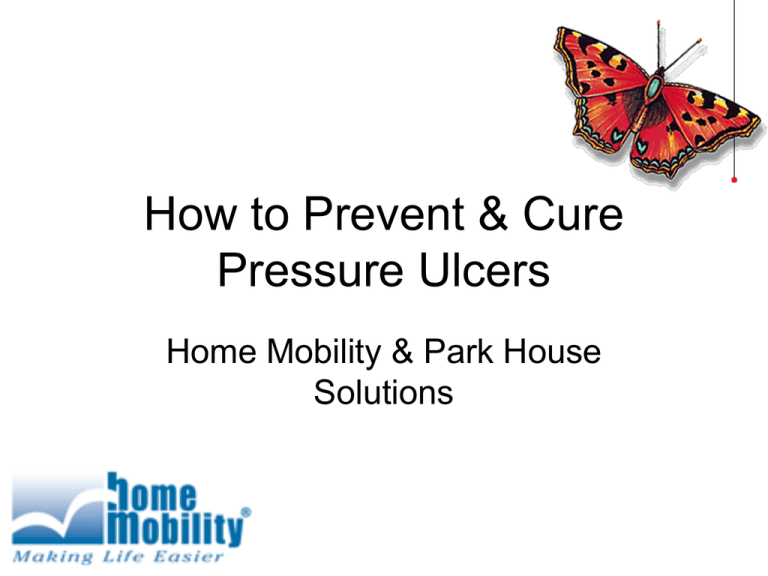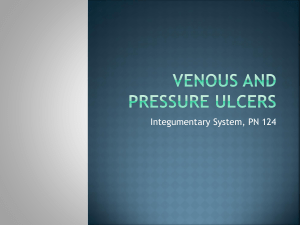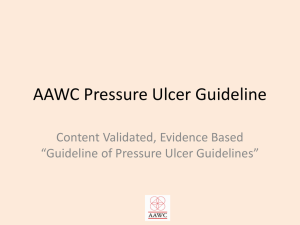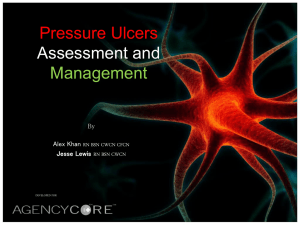How to Prevent & Cure Bed Sores
advertisement

How to Prevent & Cure Pressure Ulcers Home Mobility & Park House Solutions Overview • Pressure Ulcer – – – – – Definition Causes Predisposing Risk Factors Grades Effects on Patient • Solutions – Risk Assessment – Skin Wound Protocol Pressure Ulcer Causes of Pressure Ulcer Development Pressure Pressure Ulcer What is Pressure Ulcer? • A localized area of cellular damage resulting from: – Direct pressure: skin and other tissues are directly compressed between bone and another surface (bed, chair). Tissue damage will depend on intensity and duration of exposure to pressure. – Shearing: tissues are wrenched in opposite directions, resulting in disruption or angulations of capillary blood vessels. – Friction: skin rubs against another surface (sheet) causing epidermis to be stripped away. • Also called Pressure Sores, Decubitus Ulcers or Bed Sores Pressure Ulcer Bony Prominences at Risk Pressure Ulcer Predisposing Risk Factors • • • • • • Level of Mobility Nutrition Continence Medication Concurrent disease Age Pressure Ulcer Grades of Ulcers Two Hours … … That’s what it takes to develop a pressure ulcer. Pressure Ulcer Grades of Ulcers Grade 1 Epidermis Dermis Subcutaneous Fat Muscle Bone Redness that does not disappear when pressure is applied Pressure Ulcer Grades of Ulcers Grade 2 Pressure Ulcer Grades of Ulcers Grade 3 Pressure Ulcer Grades of Ulcers Grade 4 Pressure Ulcer Grades of Ulcers Very Fast Process Grade I: 14 Days Grade II: 45 days Very Slow Process Grade III: 90 days Grade IV: 120 Days Pressure Ulcer Effects on Patient • • • • • • • Pain Systemic illness Reduced self-esteem Altered body image Delayed rehabilitation measures Amputation Death Pressure Ulcer Solution Pressure Ulcer Risk Assessment • Why? – Because we can prevent Pressure Ulcers – Because we can cure Pressure Ulcers • To Whom? – All person with reduced mobility / activity or sedated • When? – – – – Admission Regular Intervals Change in patient conditions During day and night Pressure Ulcer Risk Assessment • Benefits? – Act as aid-memory – Target preventive care – Effective use of scarce resources – Provide quantifiable data of audit – Provides objective criteria to base care pathways • How? – Use Risk Assessment Tools Pressure Ulcer Risk Assessment Tools • Braden • Douglas • Gosnell • Knoll • PSPS (Lowthian) • Medley • Norton • N.P.R.U • Walsall • Waterlow Pressure Ulcer Skin Wound Protocol • • • • • • • Pressure Reduction Pressure Relief Incontinence Care Nutrition Consult Moisturize Skin Positioning Wound Care Pressure Ulcer Skin Wound Protocol Pressure Reduction Pressure Ulcer Pressure Reduction • Reduce the intensity of pressure and shear : Blood irrigation occlusion diminish O2 flows in tissue – Intensity is determined by contact surface (mattress or cushion). When the surface is increased, pressure is more evenly redistributed decreasing pressure. – Avoid several tissue layers because they increase the pressure – Avoid anything that reduces the size of the pressure surface (ring cushions) • Should be combined with scheduled alternated repositioning of the patient. Pressure Ulcer Pressure Reduction • Pressure Reduction can be done through specialized mattresses / Cushions • Static Mattresses are non electric system that reduces intensity of the pressure and shear by increasing contact surface • Overlay is placed over standard mattress and has the same effect as static mattress • The nature and composition of the material modify the form and the consistency of the mattress that is subject to patient body pressure. Pressure Ulcer Pressure Reduction Different Materials: – – – – – Water Static Air Gel Fiber Foam • CMHR: Combustion Modified High Resilient • Visco-elastic Pressure Ulcer Pressure Reduction Water Mattress Advantages: • Cheap • Distributes weight evenly Water Mattress Disadvantages: • A spontaneous or assisted change in the positioning is more difficult favours longer period in the same position higher risk of pressure ulcer development. Pressure Ulcer Pressure Reduction Water Mattress Disadvantages: • Very difficult to position the patient in Lateral Decubitus @ 30° (this position is recommended for long stay periods) Low comfort and increased pressure higher risk of pressure ulcer development. • Cannot be used on profiling beds (electrical) because of the weight of the mattress and the bed inclination • Cold sensation from the water patient discomfort Pressure Ulcer Pressure Reduction Water Mattress Disadvantages: • Extremely heavy weight can causes back injury to carer • The mattress can break inundation unpleasant situation for both patient and carer. • Rocking effect may cause dizziness to predisposed patients • Not durable • Requires a second mattress below Pressure Ulcer Pressure Reduction Static Air Mattress Advantages: • Easy use: once filled with air, it does not require an electric pump. • Heat build up and moisture are greatly reduced, due to the air holes throughout the mattress. • Light weight. • Best in its class for seating (cushions); however should be thick enough to prevent bottoming effect Static Air Mattress Disadvantages: • Contact surface is not increased enough to reduce pressure. • Not durable • Requires a second mattress below Pressure Ulcer Pressure Reduction Gel Mattress Advantages: • Comfortable • Viscous gel migrates through sectioned bladders to relieve pressure around bony prominences. Gel Mattress Disadvantages: • Contact surface is not increased enough to reduce pressure. • Gel can dissociate and loose all its properties. • Not durable Pressure Ulcer Pressure Reduction Fiber Mattress advantages: • High quality patient comfort • Lasting durability • Easy Maintenance • Body is enveloped by the fiber • Used for very frail bony patients • Light weight Fiber Mattress Disadvantages: • Pressure reducing properties are not enough • Rocking effect may cause dizziness to predisposed patients • Requires a second mattress below Pressure Ulcer Pressure Reduction Foam Mattress CMHR advantages: • Longer useful life than non-HR foam • High tear strength • Ability of material to revert to its original shape after pressure optimal lying comfort • Easy Maintenance • More Supple • Moulds body shape Maximize weight distribution Reduce pressure • Extremely fire retardant, complies to institutional regulatory standards Foam Mattress HR Disadvantages: • Used for Low to Medium risk patients only Pressure Ulcer Pressure Reduction Foam Mattress Visco-Elastic advantages: • Best in its class for static mattresses. • High quality patient comfort • Lasting durability • Easy Maintenance • Moulds the body allowing patient immersion thus increasing the contact surface and decreasing the pressure. • High Memory Foam Pressure Ulcer Pressure Reduction Foam Mattress Visco-Elastic advantages: • Heat sensitive property allows the top of the mattress to be more supple whereas the deeper parts remains firm for a proper support. This maintains the physiological position of the patient maximizing the weight distribution. • Used for Medium to High Risk Patient Pressure Ulcer Pressure Reduction Cover of the mattress is very important and should provide the following: • Two way stretch Reduce friction and sheer effects. • Elastic, otherwise it will limit the capacity of the mattress to reduce pressure • Vapor Permeable evacuate heat patient comfort • Fire Retardant Fire safety patient safety Pressure Ulcer Pressure Reduction • Water Resistant Prevent fluid contamination patient hygiene & safety • Concealed Zip Fastening Prevent fluid contamination patient hygiene & safety • Fully Fitted moulds to the shape of the bed Reduce friction and sheer effects • Detachable cover machine washable easy to clean patient hygiene Pressure Ulcer Skin Wound Protocol Pressure Relief Pressure Ulcer Pressure Relief • Purpose is to reduce the duration of pressure and shear by changing the points of pressure. • Pressure Relief can be done in two ways: – Scheduled alternated positioning – Specialized mattresses Pressure Ulcer Pressure Relief • Scheduled alternated positioning – Change the position of the patient in a way that body prominences at risk (points of pressure) are different. – Frequency per 24 hours/day, 7 days/week: Laying Position • Every two hours if no pressure reduction mattress is used Almost impossible to manage. • Every four hours when a good and appropriate pressure reduction mattress is used Seating Position • Every one hour if no pressure reduction cushion is used • Every two hours when a good and appropriate pressure reduction cushion is used Pressure Ulcer Pressure Relief • Specialized Mattresses are electric system that reduces the duration of the pressure and shear. • Consist of an inflatable mattress and an electric pump. • Overlay is placed over standard mattress and has the same effect as an active mattress. • The cells / compartments of the mattress inflates and deflates in alternation. • The form of the mattress, that is subject to patient body pressure, changes due to external factors (air pump). Pressure Ulcer Pressure Relief • Differentiation points: – Pump characteristics – Availability of an “intelligent” feed-back system – Diameter of the cells – Distinct compartments – Additional facilities – Cell structure – Cover Pressure Ulcer Pressure Relief • Pump characteristics: – – – – – – – – Quiet Lightweight and Compact Clear user instructions Snap fit connectors, color coded Adjustable pressure control (better if it is automatic) Audio – visual alarms Different settings: Pulsate, Therapy & Static Comfort control Pressure Ulcer Pressure Relief • Pump characteristics: – Equalized cell pressure when mattress is disconnected from power unit (transport / power failure) – Duration of the pressure: 9 to 10 minutes cycle. – External fusibles to protect the pump from current fluctuations. Pressure Ulcer Pressure Relief • Availability of an “intelligent” feed-back system : – Senses movement of patient – Automatic adjustment to individual patient weight and position – Optimum pressure is delivered at all times regardless of body mass. – Back-Raise sensor for semi-recumbent position push more air in torso section for better support prevents bottoming-out Pressure Ulcer Pressure Relief • Diameter of the cells : – Small cells (less then 10 cm) even when inflated to the maximum, do not allow the body to elevates enough above the deflated cells. – Cells larger then 10 cm are recommended. Pressure Ulcer Pressure Relief • Distinct compartments: – Individual cells easy replacement – Tri zonal: comfort for head, torso & heel – Sloping heel section • Additional Facilities: – – – – Timed static facility Static facility for fast transfer CPR facility near head section for faster deflation Intubation's facility Pressure Ulcer Pressure Relief • The cell structure - number and form: – Double layer cell structure is more efficient then single layer. – Cells are linked between each others by series of 3 and same cycle is applied for both layers simultaneously: 1st max. inflation, 2nd half inflation, 3rd total deflation 1st half inflation, 2nd max. inflation, 3rd half inflation 1st total deflation, 2nd half inflation, 3rd max. inflation Pressure Ulcer Pressure Relief • Cover : – – – – – – – – – Two way stretch Reduce friction and sheer effects. Elastic maintain reduction property of mattress. Vapor Permeable evacuate heat patient comfort Fire Retardant Fire safety patient safety Water Resistant Prevent fluid contamination patient hygiene & safety Concealed Zip Fastening Prevent fluid contamination patient hygiene & safety Fully Fitted moulds to the shape of the bed Reduce friction and sheer effects Detachable cover easy cleaning Hoses covered as per disinfections properties Pressure Ulcer Pressure Relief • Special mattresses: – Fluidized Air: Mattress is composed of silicom particles inside a synthetic cover. When hot air is injected the silicon particles liquefies. – Low air-loss: Reduce humidity build-up to to the air-loss. Pressure Ulcer Pressure Relief Fluidized Air Advantages: • The body is totally immersed in the mattress which maximizes the contact surface between the body and the mattress • Excellent system for treating burns or wounds with high exudates. Fluidized Air Disadvantages: • Very expensive • Extremely difficult to clean • Cannot be moved from 1 patient to another before a special cleaning process has taken place. Pressure Ulcer Pressure Relief Low Air loss Advantages: • Designed to provide very high degree of comfort • Constant air flow will help dry up wounds • Separate mattress system can be easily moved from patient to patient and from bed to bed. • Easy to clean and decontaminate Pressure Ulcer Skin Wound Protocol Incontinence Care Pressure Ulcer Incontinence Care • Clean skin at time of soiling • Provide quick drying surface (under pads) to the skin. • Avoid hot water and too much soap while bathing. Pressure Ulcer Skin Wound Protocol Nutrition Consult Pressure Ulcer Nutrition Consult • Diet should have adequate calories and protein, vitamins and mineral supplements. • Consult your dietician and doctor. • There is no direct link between bad nutrition and pressure ulcer prevention however nutrition optimization ameliorates the general condition of the patient and helps the cicatrisation process. Pressure Ulcer Skin Wound Protocol Moisturize Skin Pressure Ulcer Moisturize Skin • Maintain good hygiene • Wash with mild soap and warm water, rinse well and pat dry carefully and gently. • Use moisturizers for dry skin • Minimize environmental factors leading to dry skin (Low humidity, cold air) • Do not massage skin over bony parts of the body (can damage tissue) Pressure Ulcer Skin Wound Protocol Positioning Pressure Ulcer Positioning • The intensity of the pressure is determined by the weight of the patient, his positioning and the hardness of the material he is seated in. • The contact surface depends on the positioning: Surface redistribution of pressure Pressure Pressure Ulcer Positioning • Some facts: – In laying position: Avoid bottoming effect where the patient is not sustained by the mattress but lies directly on the sub-adjacent surface, specially for obese patients. – With a simple manual verification, we should not feel patient body. Pressure Ulcer Positioning • Some facts: – In laying position: when the bed head is elevated, the pressure and shear effects increase. – In seating position, the weight is redistributed in a small surface: more pressure then laying position. – In seating position, a lateral or vertical inclination increases the pressure. Pressure Ulcer Positioning • Dorsal Decubitus – Head and legs of the bed are elevated 30°: maximum reduction of pressure and shear. – Preferred positioning for long periods. Pressure Ulcer Positioning • Lateral Decubitus – Body forms a 30° angle with the mattress aided by a 30° cushion – The sacrum should not be under pressure. – Above leg is positioned behind the other one, tilted 30° at the level of the hip and 35° at the level of knee. – Positioning can be made more comfortable with cushions – Use of inflatable cushions is not recommended due to the effect of shear. Pressure Ulcer Positioning • Alternated positioning Mobilisation alternée – Use as often as possible Dorsal Decubitus positioning – Alternate with lateral Decubitus positioning • When using appropriate pressure reducing mattress, the schedule can be every 4 hours instead of 2 hours. 12 11 1 10 2 3 9 4 8 5 7 6 L 30° R 30° Semi-Fowler 30° - 30° 30° Lat. 30° Nom : Pressure Ulcer Positioning • Seating position in bed – Limit seating positions in bed because it is the cause of shearing. – Preferred position is 60° but should be limited in duration. – Use this position only for eating time. Pressure Ulcer Positioning • Ventral Decubitus – Should be used with soft mattress for comfort – To prevent pressure on feet, either place a cushion or remove end of bed and slide down patient so that feet are outside mattress. – Should observe pressure points: shoulder, thorax, basin, knees, feet, ears. Décubitus ventral Pressure Ulcer Positioning – Heel Pressure Ulcer Positioning • Seating – Slight dorsal inclination, legs resting on support and heels free of pressure – In case dorsal inclination is not possible, straight seating with both feet on floor Pressure Ulcer Positioning • Seating – Limit the duration of seating position: time spent on chair should be less then time spent in fauteuil which is less then the bed. – Armchair help stabilize the positioning of the person. – Avoid lateral and vertical sliding from chair. – Make sure that the person is well seated to provide optimum contact surface. – Cushion and backs help to keep a right positioning. The type should be studied case by case. Pressure Ulcer Skin Wound Protocol Wound Care Pressure Ulcer Wound Care - Debride – Ask your doctor - Surgical: most rapid, recommended for large necrotic areas. Mechanical: hydrotherapy, wound irrigation Enzymatic: collagenase to slow infection if present. Autolytic: via enzymes in wound fluid (very slow) - Pick a dressing (must provide a-moist wound healing) - Transparent semi permeable films (eg Opsite, Tegaderm) for Grade I & II - Hydrocolloids (e.g. DuoDerm, Comfeel, Restore) for non infected Grade II & III - Saline soaked gauze (covered by occlusive wrap) gently pack dead space for Grade II to IV - Alignates: (eg. CalciCare, Kaltostat) for +++ exudates Pressure Ulcer Wound Care - Watch for infection and treat - Ask your doctor for proper treatment. - Use dry lubricants (cornstarch) or protective coverings to reduce friction injury. Pressure Ulcer Healing signs - The pressure ulcer will get smaller - Pinkish tissue usually starts forming along the edges of the sore. - Smooth or bumpy surfaces of new tissue - Some bleeding may be present which shows good blood circulation. Pressure Ulcer Any Questions Thank You for Your Time






